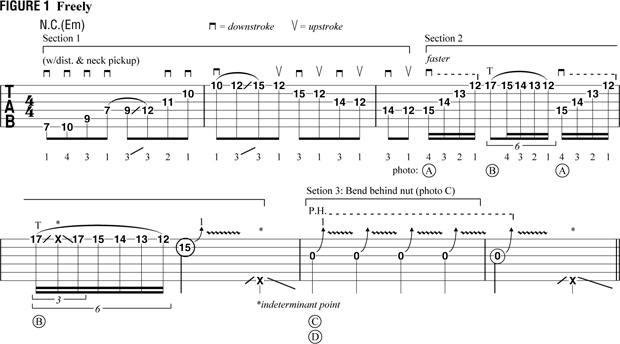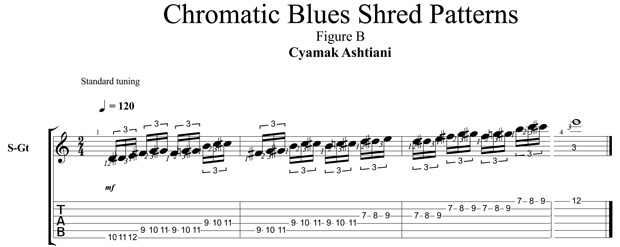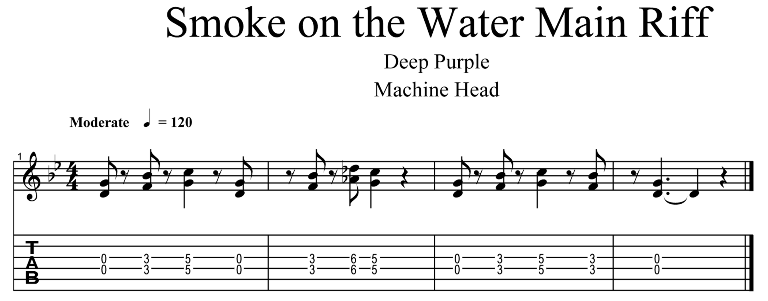Shredding is a term used to refer to a type of lead guitar playing that involves very fast runs using techniques such as tapping and sweep picking. Some of the best know shredders include Paul Gilbert, Yngwie Malmsteen, Dimebag Darrel, Michael Angelo, Zakk Wylde, Randy Rhoads, and Eddie Van Halen.
Shred guitar requires speed, dexterity, and a mastery of the fretboard that gives you the freedom to burn. Building these skills takes time and dedication. The best way to achieve these skills is through practice, building finger strength, and an understanding of scale patterns applied to the neck of the guitar.
One of the most important techniques in shred guitar is the use of sweep picking, which is a highly economical way of picking that involves using chord shapes as a basis for playing scale and passing tones at high speed. The sweep picking example shown below has no chord or time markings but uses an E minor tonality. The timing is loose and as fluid as possible.
 Shredders employ many techniques in addition to sweep picking. All of these techniques enhance speed. Hammer ons and pull offs, two-handed tapping, and heavy use of legato (smooth playing) are all features of shred guitar.
The scales used by shredders are major and minor scales, blues, and pentatonic, and very often use of the chromatic scale. Due to the speed and complexity of shredding, it’s possible to play scale tones outside of a key because the solos go so fast that non-scale tones don’t clash with the music.
The example below shows a blues-type shred using the chromatic scale.
Shredders employ many techniques in addition to sweep picking. All of these techniques enhance speed. Hammer ons and pull offs, two-handed tapping, and heavy use of legato (smooth playing) are all features of shred guitar.
The scales used by shredders are major and minor scales, blues, and pentatonic, and very often use of the chromatic scale. Due to the speed and complexity of shredding, it’s possible to play scale tones outside of a key because the solos go so fast that non-scale tones don’t clash with the music.
The example below shows a blues-type shred using the chromatic scale.
 There are lots of ways to learn the techniques of shred guitar. Video lessons on Youtube are full of top-notch shredding videos that will show you how to use the techniques described here. You can watch these videos over and over to learn the techniques, but if you want to learn to burn, there’s no substitute for practice. Start with a simple pattern like the Dm sweep picking pattern below and play it slow, gradually increasing the speed until you’re able to play it smoothly.
Once you’ve mastered this, you can find more complex patterns to work on in conjunction with the video lessons I mentioned. With patience and dedicated practice, you’ll soon be setting your guitar on fire.
There are lots of ways to learn the techniques of shred guitar. Video lessons on Youtube are full of top-notch shredding videos that will show you how to use the techniques described here. You can watch these videos over and over to learn the techniques, but if you want to learn to burn, there’s no substitute for practice. Start with a simple pattern like the Dm sweep picking pattern below and play it slow, gradually increasing the speed until you’re able to play it smoothly.
Once you’ve mastered this, you can find more complex patterns to work on in conjunction with the video lessons I mentioned. With patience and dedicated practice, you’ll soon be setting your guitar on fire.
 Shredders employ many techniques in addition to sweep picking. All of these techniques enhance speed. Hammer ons and pull offs, two-handed tapping, and heavy use of legato (smooth playing) are all features of shred guitar.
The scales used by shredders are major and minor scales, blues, and pentatonic, and very often use of the chromatic scale. Due to the speed and complexity of shredding, it’s possible to play scale tones outside of a key because the solos go so fast that non-scale tones don’t clash with the music.
The example below shows a blues-type shred using the chromatic scale.
Shredders employ many techniques in addition to sweep picking. All of these techniques enhance speed. Hammer ons and pull offs, two-handed tapping, and heavy use of legato (smooth playing) are all features of shred guitar.
The scales used by shredders are major and minor scales, blues, and pentatonic, and very often use of the chromatic scale. Due to the speed and complexity of shredding, it’s possible to play scale tones outside of a key because the solos go so fast that non-scale tones don’t clash with the music.
The example below shows a blues-type shred using the chromatic scale.
 There are lots of ways to learn the techniques of shred guitar. Video lessons on Youtube are full of top-notch shredding videos that will show you how to use the techniques described here. You can watch these videos over and over to learn the techniques, but if you want to learn to burn, there’s no substitute for practice. Start with a simple pattern like the Dm sweep picking pattern below and play it slow, gradually increasing the speed until you’re able to play it smoothly.
Once you’ve mastered this, you can find more complex patterns to work on in conjunction with the video lessons I mentioned. With patience and dedicated practice, you’ll soon be setting your guitar on fire.
There are lots of ways to learn the techniques of shred guitar. Video lessons on Youtube are full of top-notch shredding videos that will show you how to use the techniques described here. You can watch these videos over and over to learn the techniques, but if you want to learn to burn, there’s no substitute for practice. Start with a simple pattern like the Dm sweep picking pattern below and play it slow, gradually increasing the speed until you’re able to play it smoothly.
Once you’ve mastered this, you can find more complex patterns to work on in conjunction with the video lessons I mentioned. With patience and dedicated practice, you’ll soon be setting your guitar on fire. 